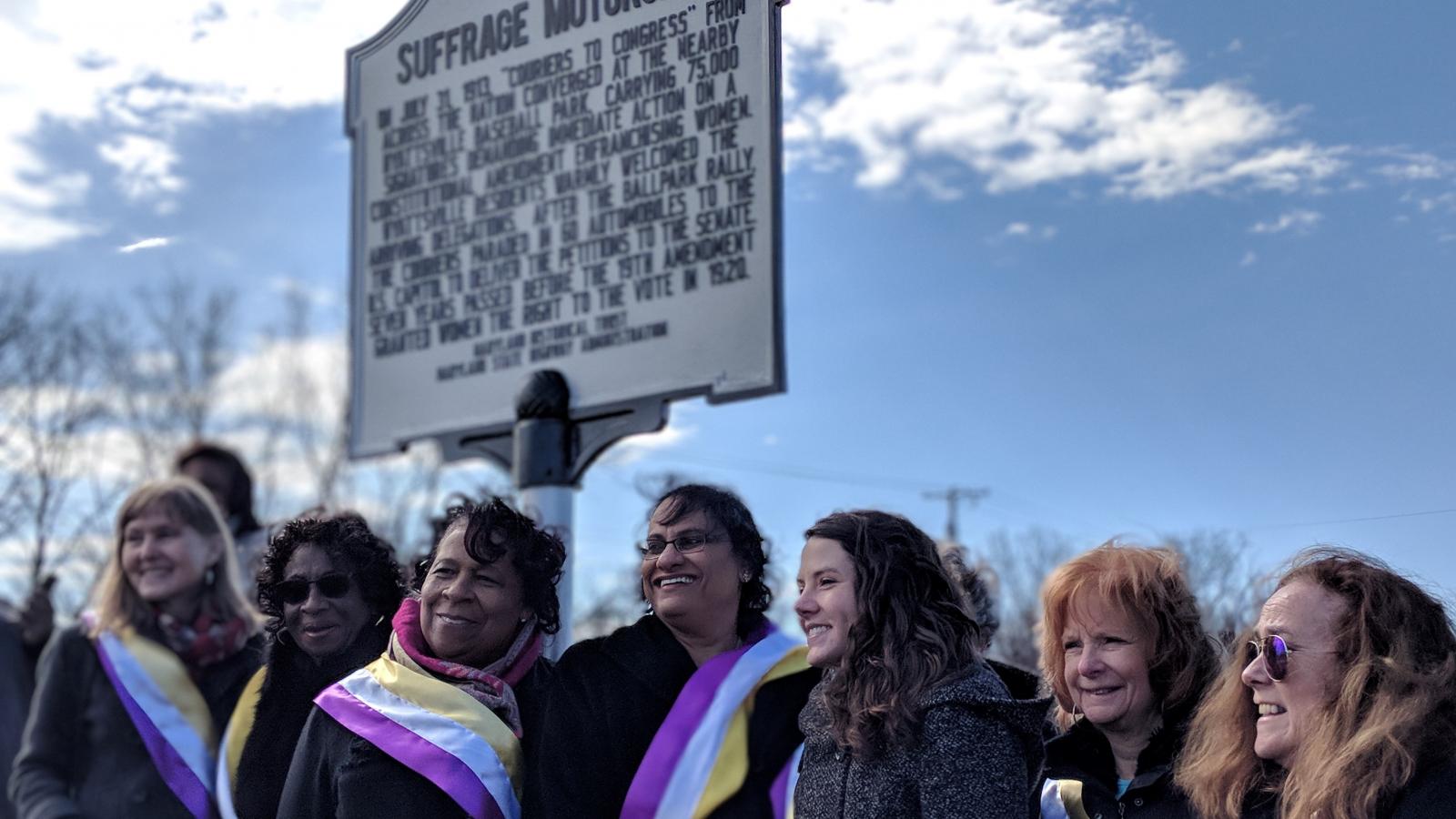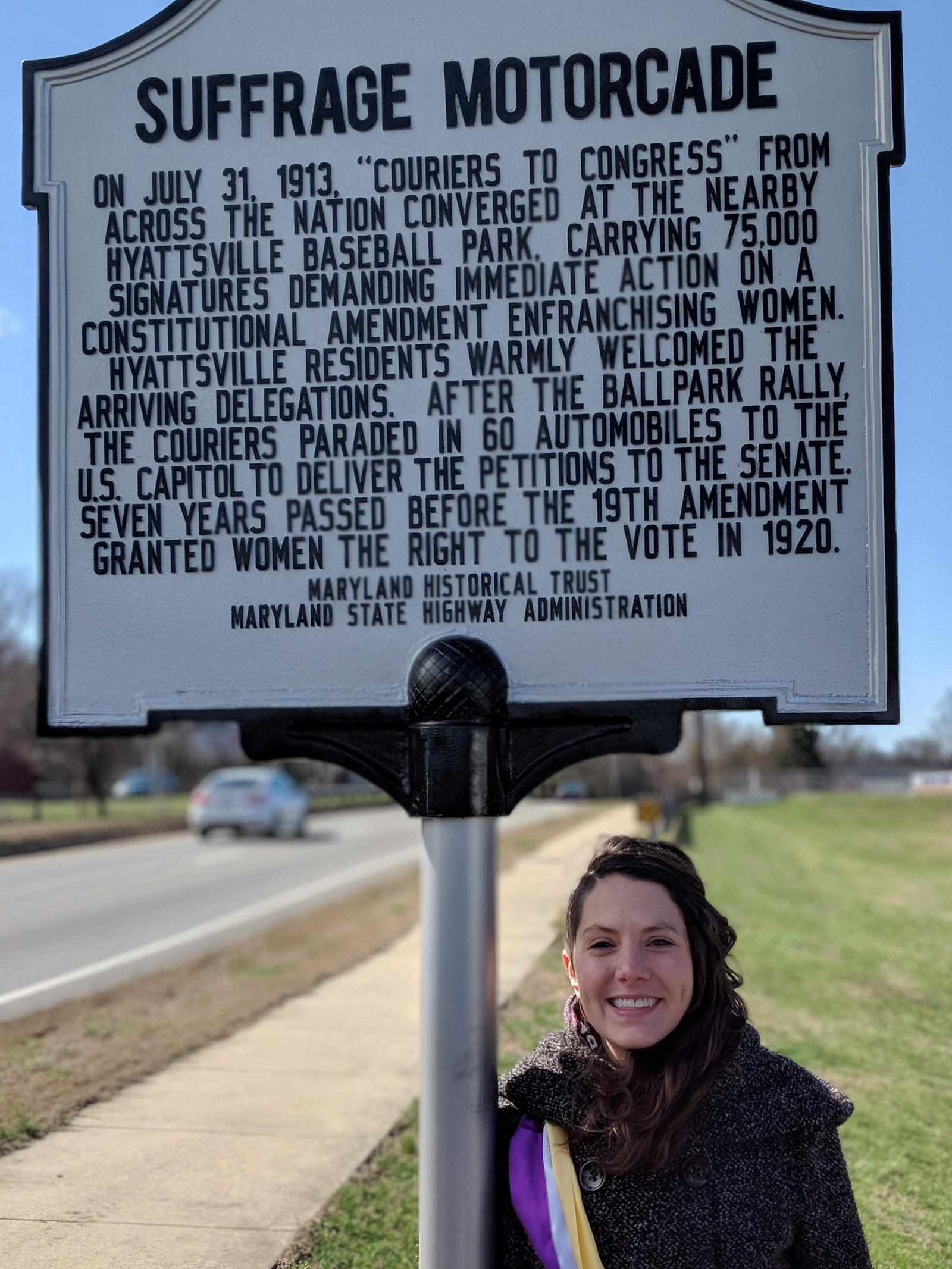On the tail of Washington’s unprecedented windstorm earlier this month, a crowd gathered in Hyattsville, Md., to commemorate a far more powerful force: the fight for a woman’s right to vote. The event marked the unveiling of a historic roadside marker signifying a landmark women’s suffrage rally in 1913. On hand was Kacy Rohn, a recent graduate from the Historic Preservation and Urban Planning Graduate Programs, and author of a comprehensive compendium of Maryland sites—over 50 in all—that were directly related to suffrage activities in the early part of the 20th century. Kacy hopes that the Hyattsville dedication, which marks the route women from across the country took to deliver suffrage petitions to congress—is a starting point for her research to be writ large across the state. “I always like seeing tangible outcomes so it was really nice seeing this marker go up,” she says. “We have two years until the 100th anniversary of the signing of the 19th amendment; I would really like to see more work accomplished to raise awareness about what happened with women’s suffrage in Maryland and to protect some of the sites associated with it. It seems like that’s happening.” In honor of Women’s History Month, we talk to Kacy about the role of Maryland women in the suffrage movement, her final project at UMD and re-discovering familiar comforts post-graduation:
Notable Project from this past year: I spent the past year completing my final graduate degree project, which examines neighborhood revitalization and historic preservation policy in the City of Baltimore and how that has changed over time. Most notably, it gauges whether we have learned the lessons needed to produce good, equitable planning and revitalization work. I found that a lot of these practices have not changed as much as we had hoped, but there is a lot of opportunity, particularly for preservationists, to take on a more active role in cities like Baltimore where there is so much going on in the historic built environment. I think that the bureaucracy makes it difficult; the main problem is these processes become politicized and fall victim to pressure to produce. That means that good, equitable processes can fall by the wayside in the rush to get things done and show off accomplishments. It takes more time to figure out what to do with historic buildings than to start with the clean slate. Preservationists can be better advocates in these processes and receive better outcomes for historic neighborhoods and their residents.
During your graduate degree you created a story map for the Maryland Historical Trust that pinpoints different “landmarks” related to women fighting for their right to vote. How did you get involved in the project? It was just sort of handed to me during my graduate internship at the Trust, which I was very happy about. The project spoke to a lot of my interests, as I had done some political organizing prior to grad school. Plus, I was doing a lot of the research during the 2016 political campaign, which really resonated with me. There was already a good body of evidence on what happened in the state’s suffrage movement and a general understanding of the key players, but as far as I know, no one had taken that and tied it to where this work actually happened. I was able to take these names and through various archives, like TheBaltimore Sun, determine where these key meetings and events took place.
Maryland was frequently involved in national actions around the movement because we are on the doorstep of the nation’s capital. People coming to D.C. would frequently pass through Maryland and stage out of Maryland, and Maryland suffragists contributed a lot to what was going on in the capital. So, Maryland had a very active state-wide campaign but was also very present on the national scene. A lot of the sites I have found have been demolished, which really speaks to the fact that we just didn’t care about this history. We came up with the idea of using the historic context developed through my research to create the story map, which pinpoints these sites, as a way share it more publicly.
What was the most interesting thing you discovered during that research? Broadly speaking, just the fact that women’s suffrage was such a vast social movement; it engaged thousands of activists across the state of Maryland. In grade school, if you’re lucky, you may learn about Susan B. Anthony, but you don’t hear about the women in your home state and your home town organizing and marching in the streets. It was fascinating to get a better understanding of how many people were involved and how long the movement took.
The flip side of that was discovering the unfortunate racist history of the suffrage movement. Women of color were often excluded from the white women’s suffrage movement, yet still had a very active movement going on that we just don’t ever hear about. It’s a very important part of the story. I had a brief interaction with the great nephew of one African-American woman, Augusta Chissell, who wrote a column in the Afro American for new voters, to ask permission to use her photo. He was thrilled, because none of his family had any idea she was involved in the movement.
Your research is now the basis of the Women’s Suffrage History Project. What is the status of that project now? I’m still working with Preservation Maryland to help build awareness around the Maryland suffrage movement, the resources we’ve pulled together and the sites we are working to preserve. In addition, the Maryland Historical Trust recently secured grant money to add some of these sites to the Maryland Inventory of Historic Properties or possibly the National Register.
Aside from your work, what’s interesting to you right now and why? I am really enjoying cooking right now. I don’t think I realized how much I missed it when I was at school and didn’t have as much time to do it, but I love to cook and I’m really happy to have more time to do that. I think its very relaxing and restorative for me with all the chaos in the world, and something nice to be able to share with other people, which is also something I didn’t get a lot of time for during school!
Last great book you read or show you binged: I just read The Devil in the White City by Erik Larson. A number of people recommended it to me during my time in the planning program—it kept coming up over and over again—and I always had it in the back of my head to read. I really enjoyed it—it’s the perfect combination of my interests in history, true crime and architecture!
What’s next? I am definitely job hunting, which is occupying a lot of my time right now. I’m also continuing the suffrage work for Preservation Maryland. I’m going to Napa for the first time in May and I am really looking forward to doing some backpacking this summer; its just such a nice thing to do when the weather’s nice.


